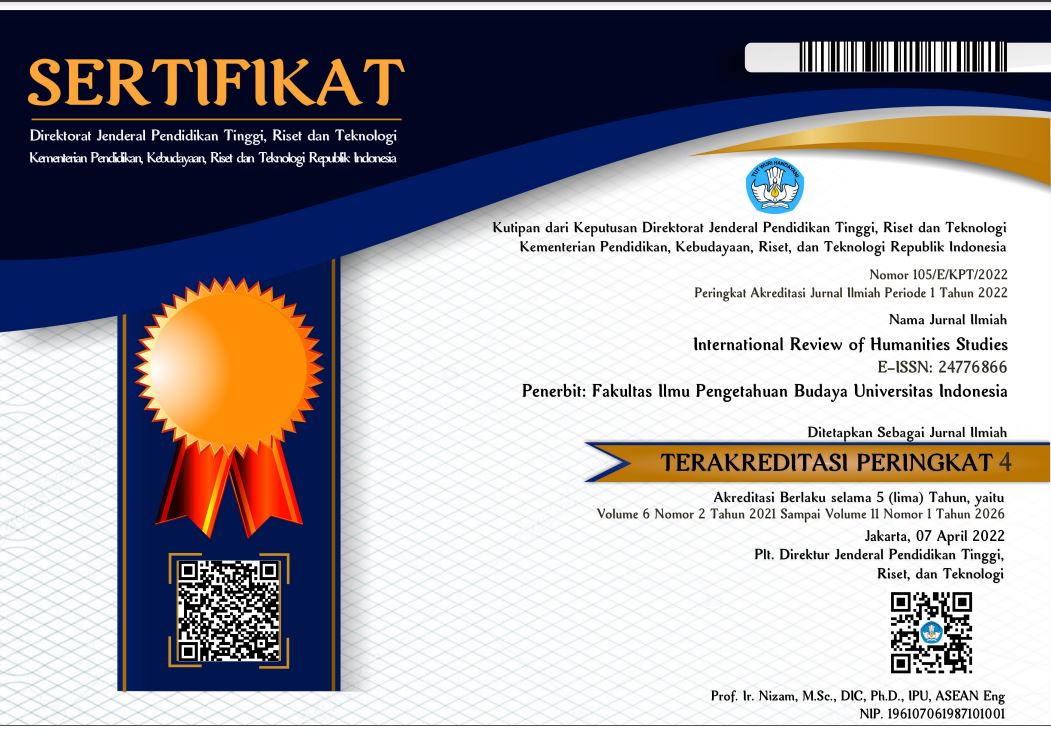International Review of Humanities Studies

Abstract
This research delves into the pavilions of Indonesia in World Expo, which is a world class cultural event involving so many countries all over the world as participants and it also attracts millions of people coming to the event of 3 to 6 months duration. Throughout the administration of Soeharto under the regime of New Order Indonesia had participated in six World Expo events out of ten events being organized; this shows how important the role of this event for Indonesia. However, from one Expo to another, it is curious that the objects chosen to be displayed in the pavilion are in fact a repetition so it raises question whether there is a certain concept being emphasized in each Expo event that the New Order regime would like to pass on by means of the displayed items continuously and whether such repetition can be considered as a form of framing and a confirmation of the symbol of power that the New Order want to show. This research is a cultural studies using qualitative approach that delve in data taken from a variety of documents such as photographs, reports compiled by committees, newspaper, magazines and internet. Data is scrutinized with semiotics analysis and theories of semiotics and framing in order to see how text is regarded as message by way of reading the created representation closely and also how the context of New Order government tried to ‘package’ it and to put the focus on the elements of objects of display in Indonesia’s pavilion at the World Expo. This research results in findings that uncover (1) meaning and representation of the objects of display of the 1986, 1988, 1992 and (2) representation of objects of display in the pavilion of 1986, 1988 and 1992 World Expo as construction of the ideology of New Order
References
Barthes, Roland. 2007. Membedah mitos-mitos Budaya Massa: Semiotika atau Sosiologi Tanda, Simbol dan Representasi (terjemahan), Yogyakarta: Jalasutra. Print
Budiman, Kris. 2011. Semitoka Visual. Konsep, Isu dan Problem Ikonisitas. Yogyakarta : Jalasutra. Print
Eriyanto. 2000. Kekuasaan Otoriter : Dari Gerakan Penindasan Menuju Politik Hegemoni (Studi atas Pidato-pidato Politik Soeharto). Yogyakarta: Insist. Print
Eriyanto. 2006. Analisis Wacana : Pengantar Analisis Teks Media. Yogyakarta: LKiS. Print
Eriyanto. 2006. Analisis Framing : Konstruksi, Ideologi, dan Politik Media. Yogyakarta: LKiS. Print
Fairclough, N. L. and Wodak, R. 1997. Critical discourse analysis. In T. A. van Dijk (ed.), Discourse Studies. A Multidisciplinary Introduction, Vol. 2. Discourse as Social Interaction. London: Sage.Print Goffman, Erving. 1986. Frame Analysis. An Essay on the Organization of Experience. New York : Harper and Row. Print Hall,
Stuart (ed). 1997. Representation : Cultural Representation and Signifying Practice. London: SAGE Publication.Print
Hoed, Benny. 2007. Semiotik dan Dinamika Sosial Budaya. First Edition, Depok: Fakultas Ilmu Pengetahuan Budaya Universitas Indonesia. Print
Lester, Paul Martin. 2000. Visual Communication: Images with messages, Belmont USA: Wadsworth. Print
Masinambow, E.K.M. dan Hidayat, Rahayu S. 2001. Semiotik Mengkaji Tanda dalam Artifak. Jakarta : Balai Pustaka. Print
North, Winfried. 1995. Handbook of Semiotics. USA: Indiana University Press. Print
Ricklefts, M.C. 2005. Sejarah Indonesia Modern 1200 – 2004 (terjemahan). Jakarta: Serambi. Print
Tjahjawulan, Indah. 2016. Obyek Pamer Anjungan Indonesia di World Expo Tahun 1986-1992 Sebagai Representasi Ideologi Orde Baru. Program Doktor ISRD ITB.
Vlekke, Bernard H.M. 2008. Nusantara: Sejarah Indonesia (terjemahan). Jakarta: KPG. Print
Vihma, Susan dan Vakeva Seppo. 2009. Semiotika Visual dan Semantika Produk, Pengantar Teori dan Praktik Penenrapan Semiotika dalam Desain. Yogyakarta: Jalasutra. Print
Recommended Citation
Tjahjawulan, Indah
(2020)
"DISPLAYED OBJECTS OF THE PAVILION OF INDONESIA AT THE 1986-1992 WORLD EXPO AS REPRESENTATION OF THE NEW ORDER’S IDEOLOGY,"
International Review of Humanities Studies: Vol. 5:
No.
3, Article 7.
Available at:
https://scholarhub.ui.ac.id/irhs/vol5/iss3/7
Included in
Architectural Technology Commons, Arts and Humanities Commons, Historic Preservation and Conservation Commons, Social and Behavioral Sciences Commons, Urban, Community and Regional Planning Commons


